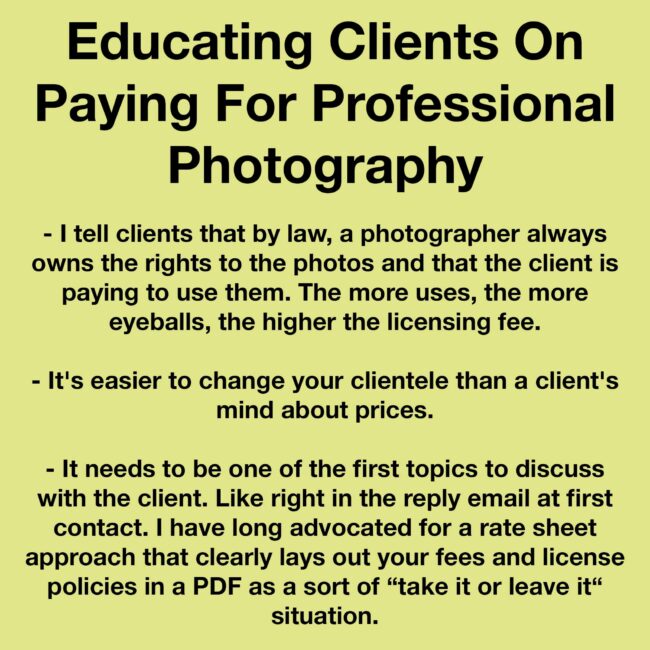
My rate structure explains what kind of usage is included and not included and it’s sent to them the minute they reach out to me, so they know. If they question the usage, I blame the government lol. I tell clients that by law, a photographer always owns the rights to the photos and that the client is paying to use them. The more uses, the more eyeballs, the higher the licensing fee. And they sometimes retort with “But so-and-so doesn’t charge me like that, I just get everything in the day rate…” And I reply “I know it’s confusing because every photographer creates the rate structure that works best for them.” I have heard that in markets outside of NYC/LA, photogs don’t always charge for licensing, so I think it’s a less challenging convo here in NYC. But the firmer I am on my policies/boundaries, the better my clients have gotten. It can be scary to say no to money, but I find it’s an energetic thing: say no to clients that question my business practices and my rates and yes to other prosperous people that value my worth.
– @reganwoodphoto
About 10 years ago, I got, from John Keatley, one of the best advices about pricing: it’s easier to change your clientele than a client’s mind about prices. If a client doesn’t understand usage, cost of doing business and production, I respectfully tell them we’re likely not a good match for their job.
– @pedrontheworld
It needs to be one of the first topics to discuss with the client. Like right in the reply email at first contact. I have long advocated for a rate sheet approach that clearly lays out your fees and license policies in a PDF as a sort of “take it or leave it“ situation. It shows potential clients that you are confident in your skills and pricing and leaves less room for haggling. Of course, this doesn’t work for all jobs, but it covers me for 80 to 90% of what I shoot. I imagine most photographers with the exception of purely agency repped advertising photographers could probably benefit from a similar approach.
– @apalmanac
This is a helpful resource: https://artistmanagementassociation.org/usage
– @post_photography
I find that even big companies in big cities still don’t understand licensing, prices. Or they do but they want it cheap and easy. Sometimes it’s better to walk away from a big name to prevent a headache. Stick to companies and clients who care!
– @karinnagylfphe
I fired clients several times early in my career. If you’re not a nepo baby you have to start at the bottom. Eventually my business was not able to afford working for certain clients so they had to go. Low-budget clients won’t suddenly come up with a pile of cash so fire them (kindly) ASAP. It’s just business and they’d do the same to us.
– @giuliosciorio
enjoying music personally on Spotify, but that doesn’t mean you can download it and use it on your YouTube video.
– @frenchlyphotography
When I get to that point, I explain what needs to be explained and then follow it with “sorry for all of that legalese, but this is how my industry operates. The bottom line is I’m making you images, and you have the license to use them how we discussed.” Works 9/10 of the time.
– @dave_pluimer
The Association of Photographers have a calculator for commercial photography. I have a gentle letter that links to the calculator explaining why commercial photography has usage limits and different pricing from personal photos.
– @really_rielle
https://digitalartthatrocks.com/blog/2020/11/10/what-is-a-usage-license-a-clients-guide-to-licensing-commercial-photography this article is a good start for the folk in the states
– @mauro_palmieri_photographer
I’m hearing a lot of ppl say just leave the client if they don’t understand. No. It’s so important to educate your clients even if you don’t want them. It’s all of our jobs to hold an industry standard and explain usage.
– @angela_peterman
This is a valid topic with a simple (and not so simple) answer. Simple: if you want your clients to pay more, illustrate and validate your value. Clients don’t just pay more because you’re telling them your services cost more, per se. Tell them WHY your services cost more (Experience? Special skill set? Ability to herd cats while still delivering A+ work?) What is it that makes you worth more? Not so simple answer: outside of big (or at least bigger) budget clients accustomed to 5 to 6 figure shoots, the creative fee + licensing model is antiquated and a huge stretch for most. Love it or hate it, it’s true. That doesn’t mean, however that you can’t still incorporate usage and time parameters into your fees. Simplify it for the client. Make it easy. Give them a lump “creative fee” that incorporates the your time and shooting skill/experience, specific deliverables, as well as usage and time parameters on the deliverables. This has been a common approach for me for the majority of my clients over the years and it is more effective, easier to understand and nearly always nets me more $$$ in the end. Ultimately, small market clients aren’t going to pay big market rates nor are they going to acquiesce to big market pricing strategy/mentality. You could educate and pontificate on your value till you’re blue in the face, but eventually you’ll realize that small market clients have a tolerance ceiling for what they’re willing to pay. And if you want to make more money, you’ll need to dial in larger market clients.
– @adambarkerphotography
I always give the example of doing a photo shoot for a small mom-and-pop coffee shop versus doing a photo shoot for Starbucks. Both shoots would have the same creative day rate and resulting photos would still be of coffee, people, places. Then, that gives me the opportunity to talk to them about usage and scale. They get it every time.
– @karlo.photo